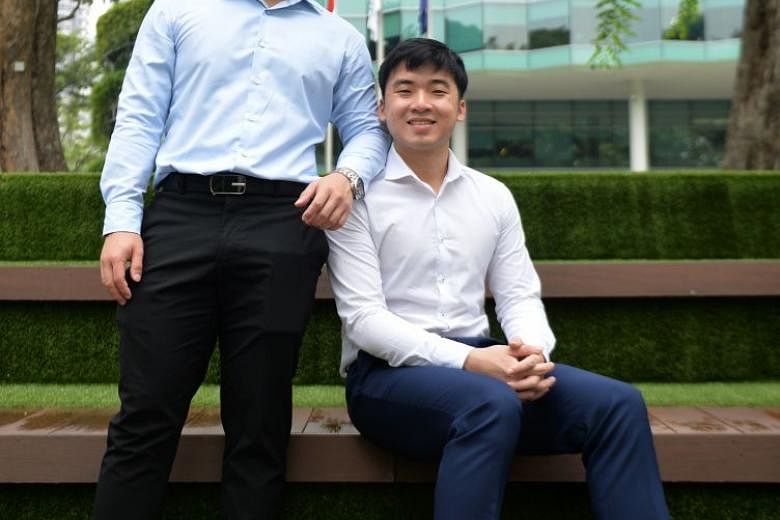Investing early and holding on for the long term are the winning strategies of a team of students from the Singapore Management University, who bagged the top prize at this year's Investor-One Challenge.
The team - Mr Yee Jin Koi, 22, Mr Kenny Chia, 25, and Mr Bryan Tan, 23 - won the stock pitch challenge against some 100 other teams of contestants by presenting their investment case for pharmaceutical company Hyphens Pharma.
They backed buying the company's stock because of factors such as rising consumer healthcare spending, demands from an ageing population and the potential dividends from the firm's investment in dermatologicals.
They also analysed the company's business model and its management. Their sharp analysis won them a cash prize of $5,000.
STARTING EARLY
All three team members said their investment journeys began early on in life.
Mr Chia, a major in finance analytics, says: "I was really into self-help books when I was in secondary school. These books often talked about financial success and how wealthy people became wealthy. Most pointed to either starting a business or investing.
"As a secondary school kid with little to no savings, the prospect of starting a business seemed unrealistic. Besides, I never thought I had business acumen.
"Investing, on the other hand, provided a more realistic proposition. I could start with a small amount and let compounding do its work for me."
He adds that he came from a low-income family, which taught him to be frugal even from a young age. His parents encouraged him to save money as a child.
"They took me to the nearest POSB bank branch to open an account. I remember I was given this kit by the bank staff that contained stickers with wise financial advice such as 'spend on needs not wants', 'track your spending', and 'save for a rainy day'.
"I stuck the stickers on my cabinet so I would be able to read them easily every day. I believe that's how I initially developed a habit of saving and living frugally."
Mr Chia recalls that the turning point came when he was in Secondary 5 in 2011 and read the book Rich Dad Poor Dad by Robert Kiyosaki.
"It changed my life and how I viewed money. It is a great primer for individuals with little to no financial literacy. The financial concepts introduced in the book were simple yet powerful."
Teammate Mr Tan, who is pursuing a bachelor's degree in business management with a major in finance analytics, says the same book inspired him and got him to learn more about investing.
"While doing national service, I spent some time to read up on equity investments," he recalls.
"I was excited about the prospect of making your money work for you and the power of compounding returns. When I was younger, I would often observe my mother checking stock prices on Teletext. That also contributed to my curiosity about the stock market."
He decided to save up $10,000 from his army allowance and use it to fund investments.
His first step was to buy 1,000 shares of Global Logistic Properties at $1.84. The company was taken private at $3.38 in 2017, so his returns were about 83.7 per cent.
"My parents always taught me to be thrifty and to spend my money wisely. I remember being told off by my parents on my first few days in primary school for using my allowance to purchase a packet of crackers instead of a proper meal during recess," he says.
"It was a simple lesson like this that helped me shape my understanding of the value of money from an early age."
His schoolmate, Mr Yee, was also inspired by his parents to start investing, and his interest was piqued when he joined the investment club in university.
"I started getting interested in investing when my parents started thinking about where to put their savings to generate greater returns, apart from the usual fixed deposit in the bank," he says.
INVESTMENT STRATEGIES
Part of the team's strategy is to take a far-sighted view of investments for future goals, such as a house or setting up a family, rather than for short-term gains.
Mr Tan says: "I adopt a long-term view for most of the companies that I invest in. Hence, I have a buy-and-hold strategy, picking out fundamentally sound companies that pay dividends.
"These companies take up about 80 per cent of my portfolio. I also allow myself to invest in more risky counters that might yield higher returns, but I mitigate downside risks by allocating a smaller position for those investments.
"I also use any excess liquidity to trade in the short term if an opportunity presents itself."
He holds United States and Singapore equities, as well as Singapore real estate investment trusts. He also diversifies his investments so no single stock makes up more than 10 per cent of his overall portfolio.
Mr Tan hopes the returns can cover the monthly cash outlay for his future home loan, plus pay out dividends for his living expenses after his retirement.
Mr Chia agrees with the need to have a diverse portfolio. He holds a quarter of his investments in American-listed companies, another quarter in Singapore-listed firms, 5 per cent in Hong Kong-listed businesses, 10 per cent in gold and silver exchange-traded funds, 5 per cent in bitcoin, and the remaining 30 per cent in cash.
His goal is to be a millionaire by the age of 35.
"I'm 25 now, so I still have 10 years to reach this goal. My aggregate portfolio value at the moment is approximately $250,000, so I will need my portfolio to grow by a compound annual growth rate of 15 per cent over the next decade."
He says he tends to seek out small-to mid-cap companies in the Singapore market with clear growth catalysts.
"It is a bonus if the companies have little to no analyst coverage. The time horizon for such positions tend to be between one and three years," he adds.
He tends to seek out larger companies in the US and Hong Kong markets with a distinctive competitive advantage or economic moat and a high return on invested capital. The time horizon for such positions tends to be beyond three years.
"Generally speaking, I prefer companies in a growing market, (with a) scaleable business model, low capex (capital expenditure) intensity, high free-cash flows, founder-led, and with management holding a significant stake in the business," he says.
Mr Yee also looks at companies with growth potential and a sustainable competitive advantage.
He adds that he is attracted to firms with stable, recurring revenue and a healthy balance sheet, together with a strong management team.
Their tips to other budding investors is to start early and do their research before jumping in.
Mr Tan says: "It is easy to get drawn in by the allure of making disproportionate returns with minimal capital.
"However, it is essential to fully understand the asset class that you are investing in. It takes patience, hard work and sometimes mistakes to build up the necessary knowledge and skills to be able to make accurate investment decisions."
Mr Chia adds: "Starting early allows you to take full advantage of the power of compounding. To me, investing is a game and I enjoy playing it. I hope to play it as long as I can, and let compounding do its magic."
Competition aims to groom investors
About 100 teams took part in Singapore's first public stock pitch challenge earlier this year, a competition aimed at nurturing budding investors across age groups and sectors.
The Investor-One Challenge was initiated by Catalist-focused portal Investor-One, which is managed by ShareInvestor and supported by stock investing community InvestingNote.
It spanned 31/2 months from registration in June to the final pitch event in September.
ShareInvestor marketing director Agnes Lim said: "The intention of the challenge was to bring together like-minded retail investors and provide access to listed-company C-level management (executive-level managers) to engage in face-to-face interactions via a series of activities: a corporate site visit, investor education workshops, quizzes and ultimately the finals."
The competition had six judges - one each from ShareInvestor, the Singapore Exchange, fund manager Azure Capital, financial service firm PrimePartners, corporate finance company SAC Capital and investment firm iFAST Corporation.
Ms Lim said: "Stock pitch challenges in the market are mostly either on an intra-school scale or restricted to a certain target audience. This challenge aims to close the gap and reach out to other stakeholders within the investing sphere such as retail investors, professionals and financial bloggers."
The teams picked a Catalist-listed company and started analysis. They had to justify their research reports, pitch their investing methodology and field questions from the judges.
The participants also engaged with their chosen company's top managers, attended investment-literacy coaching workshops by iFAST Financial, and took quizzes that helped them to learn more about investing and the associated Catalist-listed firms.
They visited pharmaceutical company Hyphens Pharma to see the facilities, attend a presentation by the chief executive and participate in a panel discussion.
Ms Lim said: "Hidden gems from the Catalist board were discovered, seasoned investors got to share their financial skills, new investors gained knowledge and Catalist-listed companies were able to put their organisations in the spotlight."
The winning team received $5,000 in cash and two runners-up walked away with $2,500 and $1,500.
Experts' advice for novices
Doing your homework and having a diversified portfolio are some key tips from experts on how first-timers can start investing.
Investing can be daunting in the beginning, but it is important that novices do their research and have their strategies mapped out, says ShareInvestor chief executive Christopher Lee, who was a judge at the recent Investor-One Challenge stock pitch competition.
He adds: "They have to ask basic questions... (such as) what they are expecting from their investments - income or capital appreciation - the time horizon and risk tolerance level.
"Also, they have to invest an amount that is meaningful. Otherwise, they may get too complacent and just park their money in the stock and hope for the best.
"The most important thing is to get their investment goals sorted out clearly and then look at the strategy to achieve those goals. I do not suggest for any novice investor to have more than 10 stocks in his portfolio at any point in time as it will require time and effort to track."
Fellow judge You Weiren, manager of stocks and exchange-traded funds (ETFs) research at investment company iFast Corporation, adds that first-timers can also kick off with ETFs, unit trusts or managed portfolios.
"If the investor is not comfortable starting with individual stock investments, he can always start with something that is more diversified. Managed portfolios, in particular, are quite suitable for investors who are just starting out," he notes.
"When investors buy a managed portfolio, they are buying into a diversified portfolio of assets that gives them exposure to major markets around the world."
He adds that an ideal portfolio should have at least these two major asset classes: equities and bonds. Investors can also include alternative investments such as real estate, commodities and private equity.
Mr You suggests that a guideline would be to deduct a person's age from 100 to find out the percentage he should allocate to equities in his portfolio.
"If you're 30 years old, your portfolio should have a 70 per cent allocation to equities and a 30 per cent allocation to bonds," he notes.
"It's not a hard and fast rule, but it's a good starting point, and if you think you can afford to take on more risk, you can adjust (the equities) to 80 per cent or maybe even 90 per cent.
"The main point is, as you age, you should allocate an increasingly higher portion of your portfolio to safer assets like bonds. For investors who want to include alternative investments in their portfolios, the percentage should be around 10 to 20 per cent."
Mr Lee adds: "I would encourage young investors to explore different investment approaches and then decide for themselves what works for them and stick to it."
Sue-Ann Tan



